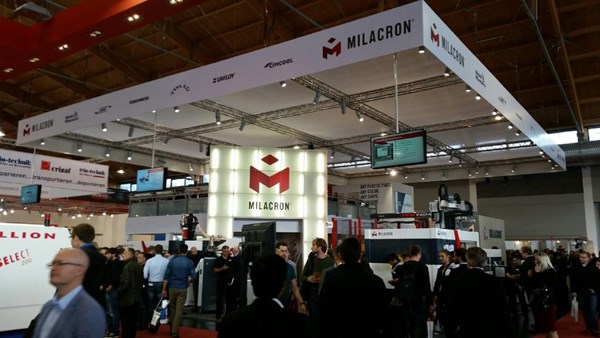“Winning With the Lifecycle Approach”
Milacron reimagines its role in the plastics industry.
In existence for 155 years, including 47 in plastics, Milacron has seen its business model (along with the industry it serves) change dramatically over the years. Most recently, those changes have included a $285 million initial public offering on June 24. Earlier this month in two investor presentations and a conference call with Plastics Technology, company executives laid out Milacron’s current interests and how those have changed in recent years, with more evolution to come.
The big takeaway? Formerly synonymous with “machinery”, the new Milacron will emphasize much more than primary processing equipment and be more present in its customers’ day-to-day business.
“We’re winning because our approach is lifecycle,” President and CEO Tom Goeke told analysts in the company’s Nov. 6 third quarter earnings call. “When a customer buys a machine, we’re there until they need to purchase a new one.” Comparing the company to a service-oriented car dealer, Goeke said Milacron’s renewed emphasis on aftermarket parts/service and what it calls consumables (think wear components), not only benefits customers by keeping their machines running with the latest kit, but makes sense financially, giving the supplier more sales opportunities.
In a Nov. 9 Baird 2015 Industrial Conference presentation, Milacron said 61% of its sales come from those consumable products—a “high margin recurring revenue stream.” Consumables here include aftermarket, fluids, and melt delivery/control systems, with the remaining 39% of revenue attributable to “equipment systems.”
In that same presentation, Milacron noted that while an injection molding machine can have a replacement cycle ranging to 15 to 25 years, items like hot runners, mold bases and other components can require new investments every one to five years due to wholly new projects or wear on existing tools.
On the existing equipment front, the company sited large installed bases of machines (40,000) and hot runner systems (140,000) as potential sources of ongoing aftermarket business. Looking forward, Milacron forecast 7.1% CAGR in processing equipment, with the total to rise from $25.3 billion in 2014 to $31.1 billion in 2017. Business here would be fueled by upgrades in emerging regions and replacement of aging fleets in developed markets. The global hot runner market was pegged to grow at 8% CAGR, rising from $2.1 billion in 2014 to $2.6 billion in 2017.
In the earnings call, executives referenced several bright spots, including an expanded hot runner plant in India and a “very successful” Fakuma, where the company presented as “one Milacron” for the first time in Europe, with close to 1000 leads booked at the Friedrichshafen event.
On the technology side, testing continues on its coinjection molded answer to tin cans for food packaging, the Klear Kan, with collaboration ongoing with select prospects, up to and including focus groups with consumers.
The company noted that it has sold three of its new PET preform systems, which launched at NPE, with the first being shipped and two more being manufactured. In automotive, Milacron executives talked up interest in a four-component machine for applications like taillights, which require multiple materials/colors.
On a geographic basis, the executives did describe a slow down in Asia in general, and China in particular. Overall the region was a wash with increased business in Singapore, Vietnam and South Korea largely offsetting contraction in China.
In North America, Milacron has seen what the executives called a general slow down, with strength in automotive, appliance, housewares, and custom molding ongoing, but weakness in construction. North America still constitutes a slim majority of Milacron’s business (52% of revenue), with Asia (22%) and Europe (21%) accounting for next biggest chunks. By end market, automotive (23%) and packaging (21%), dominate.
Goeke told Plastics Technology that the company spends around $20 million/year in R&D, and at the Baird event, a long-term goal of generating more than 20% of revenue from new products was stated, laying out the potential for a win-win for Milacron and its customers.
“At the end of the day, our customers are trying to make higher quality parts at a lower price,” Goeke said, “so everything we can do with precision of the part, is a benefit to them.”
Pictured: Milacron's Fakuma booth, image courtesy Milacron

Read Next
Making the Circular Economy a Reality
Driven by brand owner demands and new worldwide legislation, the entire supply chain is working toward the shift to circularity, with some evidence the circular economy has already begun.
Read MoreBeyond Prototypes: 8 Ways the Plastics Industry Is Using 3D Printing
Plastics processors are finding applications for 3D printing around the plant and across the supply chain. Here are 8 examples to look for at NPE2024.
Read More




















